Guiding catalogue of assistive products and minor home adaptations as given in the Services Act section 117 a
Last updated 27-03-2025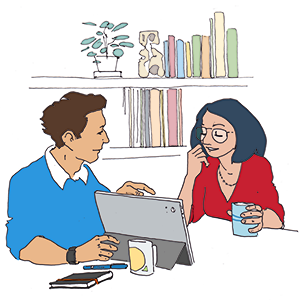 This catalogue has been developed as a guiding tool for municipal caseworkers and citizens. It presents assistive products administered in section 112 of the Services Act and minor home adaptations administered in section 116 the Services Act, in relation with section 117 a in the Services Act on faster and more flexible help for citizens with a rapidly progressing disease. It should be noted that the catalogue is not exhaustive.
This catalogue has been developed as a guiding tool for municipal caseworkers and citizens. It presents assistive products administered in section 112 of the Services Act and minor home adaptations administered in section 116 the Services Act, in relation with section 117 a in the Services Act on faster and more flexible help for citizens with a rapidly progressing disease. It should be noted that the catalogue is not exhaustive.Citizens who are affected by a rapidly progressing disease will often experience a loss of functioning that affects their ability to function in relation to e.g. mobility, managing necessary tasks and functions in the family and in the household, the ability to maintain social relationships, etc. Therefore, it will be relevant to offer citizens with a rapidly progressing disease a combination of personal care, practical assistance and food service, supportive escort, selected assistive products, and minor help for home adaptation, from the local authority council, immediately when they apply for the first time, without prior customary assessment.
According to the Services Act section 117 a, when a citizen with a rapidly progressing disease make their first contact and request this, the local authority council must offer personal help and care, practical help or support and food service according to section 83, supportive escort according to section 97, selected types of assistive products according to section 112, and minor help for home adaptation according to section 116, according to the citizen’s preferences, for a total maximum value of DKK 39.750 (2023 level), regardless of whether the conditions in the mentioned legislation are met. The local authority council must assist the citizen with guidance in relation to choosing the composition of help and support, etc. The Minister of Social Affairs and Housing stipulates detailed rules on the criteria for assessing whether a citizen falls within the scope, and which types of assistive products according to section 112 and which help for home adaptations according to section 116 are included in the help that the citizen can choose from.
The target group for the provision is children, young people, and adults with a rapidly progressing disease.
This catalogue is divided into different function and activity related subject areas with suggestions on relevant assistive products according to section 112 of the Services Act and minor help for home adaptations according to section 116. The suggestions are limited to product categories, which are expected to contain products that, in terms of price, are within the economic limits outlined in section 117 a, part 1, of the Social Services Act.
The catalogue is not exhaustive, and there may well be other products than here mentioned, which could be relevant for the individual person and that in terms of price are within the economic limits.
Assistive products for personal mobility and transportation
E.g. walking sticks, rollators, wheelchairs and special cycles.
Depending on your level of ability, you may need different assistive products that can enhance your ability to move around, and with a rapidly progressing disease, your level of ability can change soon. Therefore, this catalogue contains a large variety of assistive products for mobility, here divided into assistive products for walking, manual wheelchairs, special cycles, and devices to facilitate getting in and out of a vehicle.
Assistive products for walking
Depending on your walking ability, there are different types of assistive products for walking to choose. If you have slightly reduced walking ability, you will often be able to manage with a walking stick or a crutch. If your walking ability is severely reduced, you may need a rollator or a walking table.
Walking sticks
There are different types of walking sticks that can be used for if your walking is unsteady, e.g. walking sticks with special handles that provide a good grip.
Please read more in the:
Rollators
If you need more support than a walking stick can provide, a rollator may be relevant. The most common rollators are those that you push in front of you. You should consider whether the rollator is to be used outdoors, indoors, or both. On most rollators, it is possible to mount a small tray or basket at the front. Rollators for outdoor use typically have a resting seat.
Please read more in the:
Walking tables
If you need more support than a walking stick or a rollator can provide, a walking table may be suitable. Walking tables are similar to rollators with arm support at chest height, supporting the forearms. It allows for a more secure support, especially if your arms are significantly weakened.
Manual wheelchairs
With severe to moderately reduced walking ability, a foldable wheelchair can make it possible to go on trips outside the home. The wheelchair typically has to be pushed by an assistant. A propulsion unit can be mounted to the wheelchair to provide relief. The propulsion unit can be either user or assistant controlled.
A manual wheelchair can often be carried in a passenger car.
If you have to use a wheelchair for a long time and many hours a day, it must be adapted specifically for you by a professional.
Special cycles
If you usually walk but need to get around over a greater distance than your walking range, a special cycle, e.g. a twin cycle, a tandem, or a tricycle with special properties can be a solution. Please note that cycles without special properties, e.g. regular powered cycles or carrier cycles, to start with will not be considered assistive products according to the Services Act.
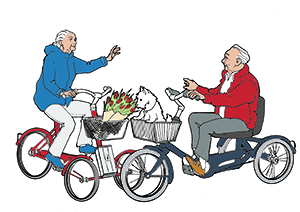
On tandems, two persons sit one behind the other, and they are available with both two wheels and three wheels. If the tandem has three wheels, it is easier to keep the balance, especially when getting on and off the tandem. On twin cycles, you sit next to each other.
Some cycles have a low entry height, where you don’t have to lift your foot high to get on and off. There are also cycles that have the seat positioned low, like a chair seat, which both makes it easier to get on and off and provides a lower centre of gravity.
Please read more in the:
Assistive products for changing body position
E.g. grab bars, assistive products for sliding and turning, turntables, devices to facilitate getting in and out of a vehicle, assistive products for lifting persons, and body support units for hoists.
There are various assistive products for transfer or changing position, used either by yourself or with the help from others.
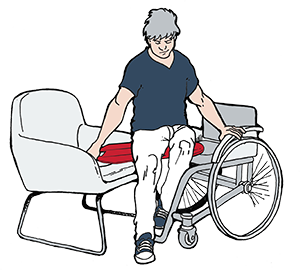
Depending on your level of functioning, you may need assistive products for transfer, e.g. between a wheelchair and a bed (sliding board, mobile hoist, or hoist hanging from the ceiling), between a wheelchair and a chair or a toilet (sliding board, grab bar, toilet support or mobile hoist) or between a wheelchair and a car (sliding board, swivelling cushion or hoist).
- Assistive products for changing body position
- Assistive products for lifting persons
- Devices to facilitate getting in and out of a vehicle
- Supporting handrails and grab bars
Please read more in the:
Assistive products for communication
E.g. communicators, voice amplifiers, communication software, symbol boards, writing and reading products, and emergency calls.
Assistive products for communication include assistive products for both verbal and non-verbal face-to-face and distant communication, as well as one-way, two-way, multi and mass communication. Individual customization and training in the use of assistive products for communication is important, both for the person with impaired communicative ability, for relatives and for other people in the environment.
There are low-tech and high-tech assistive products for communication, and often there is a need to use a combination of several types of products to achieve a good solution. The following types of products are often included in communication solutions:
- Dialogue units
- Face-to-face communication software (including symbol and script-based communication software)
- Letter and symbol sets and boards
- Personal emergency alarm systems (e.g. emergency alarm systems)
- Assistive products for distance communication (e.g. telephones and entry phones)
Please read more in the:
Assistive products for operating and for environmental control
E.g. switches, five-or-more-function-contacts, remote controls, lighting control systems, devices for grasping, devices for assisting or replacing arm, hand, or finger function.
If you have problems operating functions or appliances in everyday life, it may be relevant to find alternative solutions or use special assistive products, e.g. to open and close a window, to operate lighting or the television, to use a telephone or a browser, or to operate a household appliance.
Some products can be set up or adjusted so that the operating functions are adapted to your needs. For instance, browsers, apps, and operating system can be adjusted to improve accessibility if you have impaired vision, hearing, or motor skills. User interfaces can also be customized with e.g. shortcuts and icons.
An increasing number of products can be connected to Wi-Fi or connected via Bluetooth. This makes it possible to remotely operate a wide range of devices and functions, such as lighting, media players, curtains, and household appliances. The remote control can, e.g. take place via an app or by voice control.
- Assistive products for operating and controlling devices
- Environmental control systems
- Assistive products to assist or replace arm function, hand function, finger function or combination of these functions
The options for operating via apps can require special features on a tablet or a smartphone, e.g. requirements for size, a specially adapted operating system, or requirements for sturdiness.
Please read more in the:
Assistive products for structure, overview and memory
E.g. special calendars and timetables, countdown timers, software and hardware for visualizing sequences, medication reminders, and tools that support daily routines.
Impaired concentration, memory difficulties, or difficulty in planning a work process can be part of the symptom picture in some persons with a rapidly progressing disease.
Perhaps it can be an advantage for you to make an overview of the day’s activities and appointments using a calendar or a timetable. These type of products are available both as products that have been developed specifically for people with reduced ability and as mainstream products with functions or adaptation options that may be useful for the individual.
The products are available as electronic devices, as apps, and in paper formats.
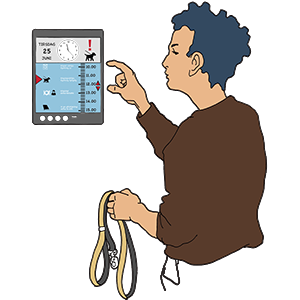
Some have a reminder function that can help you remember tasks and appointments, some have a visual countdown timer so you can see, for instance, how much time is left in an activity. Some provide voice messages, others are particularly suitable for visual support with images or symbols. Finally, some products you can programme to contain individually adapted routines.
- Calendars and timetables
- Countdown timers
- Assistive products for structuring periods, activities and personal goals
- Memory support products
Please read more in the:
Assistive products for bathing and personal care
E.g. shower chairs, bathtub seats, brushes with special grip, and assistive products for skin care, hair, and nails.
Various assistive products can make it easier to bathe and manage care of skin, hair, and nails.
With a shower chair or a shower stool, you can sit down when showering. If you have a bathtub, you can use a board or a seat that is mounted on or in the bathtub. There are different brushes that make it easier to wash the feet, the back, and other places on the body that are hard to reach.
With a non-slip mat and perhaps a wall mounted grab bar, you will be even more protected against falling.

- Shower chairs with and without wheels
- Bathtub boards
- Bathtub seats
- Non-slip bath mats, non-slip shower mats and non-slip tapes
- Supporting handrails and grab bars
- Washcloths, sponges and brushes with holder, handle or grip
Please read more in the:
For the care of skin, hair, and nails there are, e.g., assistive products for applying lotion to the skin, brushes and combs with long handles, and nail clippers, adapted for persons with reduced strength.
Please read more in the:
Assistive products for toileting
E.g. raised toilet seats, toilet arm supports, commode chairs, and toilets with built in douche and drying functions.
If you have difficulty sitting down and getting up from a regular toilet seat, a raised toilet seat can often be essential for whether you can handle toileting yourself. The raised toilet seat can e.g. be supplemented with a grab bar on the wall. If you feel insecure when sitting on the toilet, arm supports can be mounted on the toilet seat or on the wall behind the toilet. A toilet roll holder can be mounted on the arm support so that you can reach the paper yourself. If you cannot sit on the toilet at all, or if you cannot get to the toilet, a commode chair could be a solution. If you can’t get out of bed, you might want to use a urine bottle.
If your hand or arm function is impaired, a toilet paper tong might be a simple solution. If you cannot handle such tongs, a toilet seat with a built in douche and air-drying function may be appropriate.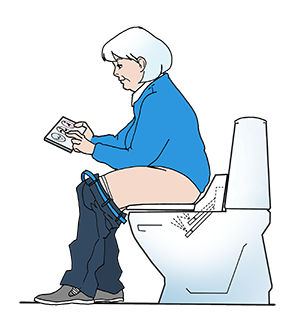
- Assistive products for toileting
- Non-body-worn urinals and urine bottles
- Supporting handrails and grab bars
Please read more in the:
Clothing and assistive products for dressing
E.g. orthopedic footwear, specially made garments, assistive products for putting on or removing socks, jacket and trouser aids, and dressing and undressing hooks or sticks.
There are various types of custom-made clothing and footwear that can either give you extra support and comfort, or that are practically designed for use in a wheelchair.
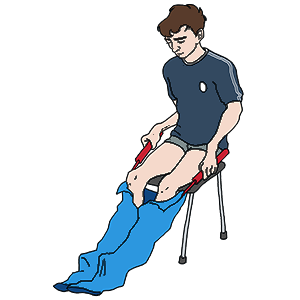
There are also a number of assistive products for undressing and dressing. If, for instance, you have difficulty reaching down to your feet, a long shoe horn, an assistive product for putting on or removing socks, or a dressing and undressing stick can be a solution.
There are also alternative fastening mechanisms if you have difficulty handling buttons, zips or laces.
- Assistive products for dressing and undressing
- Clothes and shoes
- Orthopedic footwear
- Anti-oedema stockings
Please read more in the:
Assistive products for sitting and lying down
E.g. chairs with special functions, furniture leg extenders, positioning pillows and positioning cushions, side rails for beds, and care beds.
If you cannot or have difficulty in getting up from or sitting down on a chair, you may consider mounting leg extenders on your seating furniture. There are also chairs with special functions.
- Leg extenders
- Cushions or systems added to seats to assist a person to stand or sit
- Easy chairs with electrical adjustments
Please read more in the:
If you need to sit down doing your daily tasks, it may be relevant with a standing chair or an activity chair, possibly with central brake. Some chairs can be adjusted so that they can support you a half-standing position.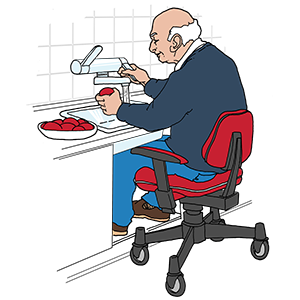
- Standing chairs
- Activity chairs with brake and gas spring operated height adjustment
- Activity chairs with brake and electrical height adjustment
Please read more in the:
If you have an increased need to lie down, if you stay in bed during meals and conversation, or if you need help getting in and out of bed, a care bed or bed base with electric functions can be a solution.
Please read more in the:
If you find it difficult to find just the right position for rest or support, various positioning cushions may be relevant.
Assistive products for eating and drinking
E.g. cutlery, glasses, straws, plates with a special design, and feeding apparatus.
There are specially designed cutlery, tableware, and grip adapters and attachments. You can find, for instance, cutlery that is made of a very light material, plates with a high edge, sharp knives, or forks with particularly sharp teeth. It can also be helpful to use mugs or glasses with one or two handles. Handles are also available as loose attachments that can be used on various mugs and glasses, just as there are straws with a valve so that the liquid that has already been absorbed in the tube does not flow back into the glass.
Furthermore, there are electric or manual devices (feeding apparatus) that can enable you to independently bring food from a plate to your mouth, even if you do not have the ability to handle cutlery.
Please read more in the:
Assistive products for housekeeping and cooking
E.g. tools and appliances with special operation options, special functions, or special design.
If your arm or hand function is impaired, even simple assistive products can make a big difference. For instance, tap handles, lid and packaging openers for e.g. screw caps, cans, bottles, and milk cartons, non-slip pads, potato peelers, and several other tools.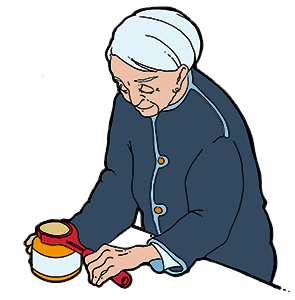
If you find it difficult to grab the utensils in your kitchen, you can use a grip adapter that you put on to what whatever you find difficult to hold.
If you need to sit down while doing housework, an activity chair might be a good solution, possibly in a high version – a standing chair – which can support you in a semi-standing position.
When laying a table and cleaning up, it can be helpful to use a tea-trolley. You can also use the trolley to transport other things around in your home.
- Assistive products for preparing food and drink
- Openers
- Universal grips
- Peelers
- Assistive products for cutting, chopping and dividing to prepare food and drink
- Scissors
- Grip adapters for mugs, bottles and milk containers
- Trolleys
Please read more in the:
Assistive product for sensory stimulation
E.g. weighted covers and weighted vests.
Assistive products for sensory stimulation can be a help if you have trouble sleeping, symptoms of stress, or concentration problems.
There are various assistive products for sensory stimulation, which may well be a relief in your everyday life. It includes for instance, weighted blankets and cushions and weighted vests.
Please read more in the:
Assistive products especially for children
E.g. electrically height adjustable diaper-changing tables, special play and activity equipment, as well as special car seats, cots, high chairs, prams and strollers.
Bath
When your child is small, you can wash them in a small bathtub, possibly a bathtub that is height adjustable. There are inserts for bathtubs that support the child’s head and body and ensure that the child does not get his/her head under water.
If your child is able to sit, you can use a seat placed in an ordinary bathtub. The seat can be adjusted to the individual child and may have a lifting mechanism.
If you do not have the opportunity to bathe your child in a bathtub, you can use a shower chair in the shower. Shower chairs are available with or without wheels and with more or less support for the child.
If you cannot bathe your child in a bathtub or in a shower, a height adjustable shower bed could be an alternative. For an older child, it would be good to combine the shower bed with, for instance, a hoist mounted in the ceiling to avoid too many heavy lifts.
When your child needs to be washed and changed, an electric height adjustable changing table can be a good help.
- Bathtubs
- Bathtub seats
- Shower chairs with and without wheels
- Bathing stretchers, shower tables and diaper-changing tables
- Bath mats
- Non-slip coverings
- Assistive products for lifting persons
Activities on the floor
If your child is to play on the floor, the child may need to be physically supported. If the child’s activities take place lying down, the child can use stabilizing positioning systems. If the child will be playing in a sitting position, the child can use a special sitting furniture that supports the child in the sitting position.
Bed
If your child needs much help in bed, it will be a great advantage if the child has a bed with electric height adjustment, so that you will have a comfortable working height when you help your child. Beds are also available with several options for positioning, which may be relevant, depending on your child’s needs.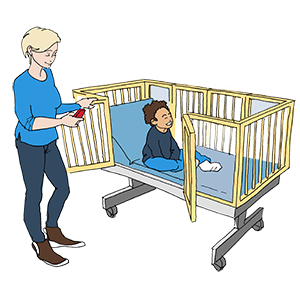
It may be necessary to use positioning cushions to support your child’s position to prevent malalignments in the joints.
- Beds and detachable bed boards/mattress support platforms with powered adjustment
- Positioning pillows, positioning cushions and positioning systems
Please read more in the:
Food and drinking
If your child has difficulty using ordinary cutlery and tableware, you can use specially made cutlery. This can be, e.g., very light cutlery, cutlery with adapted handles making it easier for the child to hold on to it, or cutlery that is gentle on teeth and gums.
To help your child drink from a glass or a mug, you can use grip adapters mounted on the glass or mug. There are also mugs with drinking lids and mugs with a recess for the nose, so that the child can drink from it without having to extend the neck too much.
If the food tends to slide around on or off the plate, you can use plates with compartments, plates with high edges or loose plate edges that you can attach to your regular plates. You can also get plates with a suction disc at the base, so the plate sits firmly on the table.
- Cutlery and straws
- Grip adapters for cutlery
- Grip adapters for mugs, bottles, and milk containers
- Plates
Please read more in the:
Communication and alarms
If your child’s ability to communicate is impaired, using aids for communication could be an option. For instance, a dialogue unit where the child activates an electronic voice by striking keys or other forms of pointing out on a keyboard or a screen. There are also low-tech products for communication, e.g. symbol sets and symbol boards to communicate by pointing out pictures or words.
You might want to use an alarm system if your child is unable to call for you. It could be, e.g. a baby alarm, but there are also various alarm systems with manual or automatic activation, with or without two way speech, etc.
Toys and games
There are specially developed toys and games that can be relevant, both in relation to developing and supporting your child’s motor skills and in relation to supporting your child’s social development.
For both indoor and outdoor use, you can get special swings that have specific support for the body, or swings where the child can lie down.
If your child uses a smartphone, tablet or games consoles, but finds it difficult to hold them, you can get various holders that you can fix the equipment into to place it within the child’s reach.
Please read more in the:
Transportation
If your child can’t sit independently, there may be a need for a special child seat for the car that provides extra support. There are also special buggies that provide extra support for the child.
Home adaptations
E.g. removing thresholds, widening doorways, door automation, adaptation of kitchen or bathroom, ramps, light fixtures and installation of handrails
Minor home adaptations can ensure that your home remains suitable, even if your functional level changes. It is individual and dependent on your home, which home adaptations are relevant. For instance, removing thresholds, widening doorways or setting up a ramp at the entrance door can make it possible to get around with a rollator or a wheelchair.
A minor home adaptation can also be furnishing or adapting a bathroom or the kitchen or installing support handles or handrails in the home.
Legislative framework
This guiding catalogue is based on the following legislative provisions:
- The Services Act, section 117 a, Help and support for citizens with a rapidly progressing illness
- Consolidated act on help and support for citizens with a rapidly progressing illness
- Guidance notes on help and support for citizens with a rapidly progressing illness
Any principle decisions from the National Social Appeals Board, which refer to the Services Act section 117 a, can be found on the following overview:


